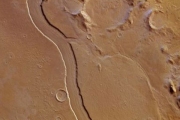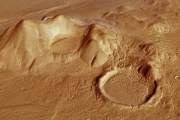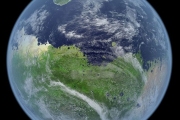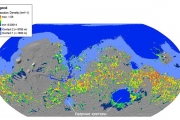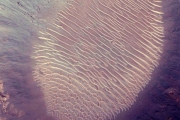Viewings: 8913
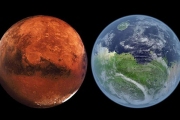
Real Wallis - region of Mars, structure similar to the trace from the river channel, which took the spacecraft "Mars-Express". Scientists believe that this structure was formed thanks to the moving stream of water in the distant past of the red planet.
The stream flowing in the area of upland Prometheus-Terra, went to a huge pool Hella, and left behind a channel with blurred banks.
Last year, the machine could photograph the amazing upper part Raul Wallis and make clear high resolution images using a stereo camera.
This winding structure, which extends almost 1,500 kilometers, crossing the Martian landscape. The channel is adjacent to a large number of tributaries, one of which is visible in the main valley, in its Northern part.
On the picture you can see the place Real Wallis where naked channel reaches almost 7 kilometers wide and 300 meters deep. The banks of the former river especially steep and slightly flattened, as if the treated water, with parallel lines running along the bottom.
There are suggestions that these lines were formed when the flow freely moved loose rocks and chunks of ice in the era of the Amazon period (which is still ongoing), when along this channel was moving ice flow.
However, this channel was formed by liquid water long before this, in Kaspereskey era, which, according to the researchers, came to an end 3,5 -1,8 billion years ago.
Similar lined patterns were found in many nearby craters.
Photos taken from a height, it is clear that the inflow, which crosses the main channel, as it turned out, is ambivalent: two its branches are joined into one before the influx will connect to the main channel.
In the Northern part of the picture there is an upland Prometheus-Terra, mountains which rise to a height of 2500 meters above the surrounding valleys.
Top view Real Wallis shows a striking similarity with the morphology of the earth terrain, which was affected by glaciers.
For example, we can see a line similar to the marks of the level, on the internal walls filled with sediments of the crater in the foreground. Researchers believe that these were the traces of water level (liquid or solid), which gradually step by step evaporated and left in different periods of time.
Structure Real Wallis suggests that this area is complex and varied history, similar that we can observe on the Earth, in the area of activity of glaciers.
These analogies allow geologists to imagine the distant past of the red planet. The researchers believe that many of the events on Mars is not too different from the events that took place on Earth.
Water on MarsThat Mars once had water, found confirmation for a long time. Pictures of spacecraft and Rovers working on Mars show that the flows of liquid water cut Martian surface along and across. Moreover, in the Northern hemisphere of the planet was once a giant ocean of liquid water.
If today on Mars was water...If today on Mars was liquid water, as in the past, it could look like this:
These images were created by engineer from USA Kevin Gill, who presented the Red planet, filled with water.
And still water on Mars there, but mostly in the form of ice, which is concentrated near the poles. However, the ice caps at the poles not only contain water ice, and solid carbon dioxide. Scientists still can't find evidence that liquid water is somewhere under the surface, however, it is quite likely.
After studies of lake Vostok on the Earth, it became clear that ice water can remain liquid whole era. If Mars had liquid water until the polar caps, there is every chance that it exists there today.
In 2011, the space Agency NASA said that on Mars sign of Brooks of water, which appear seasonal, and then dry up.
Where did the water from Mars?The blue area is estimated Martian ocean. Yellow, red and green - valley formed by water streams flowing from the South to the ocean in the North
According to one version, the water from Mars lost by the fault of the solar wind. This wind is a stream of charged particles that gets to all objects of our Solar system. Solar wind could destroy the atmosphere of Mars, which was lost water.
Studies have shown that the solar wind is very deeply able to penetrate into the atmosphere of the red planet and to carry into space about 1 kilogram of the material per second! Apparently, after many millions of years, almost all the water so it has evaporated.
This image, like a fingerprint, was shot in the district of the valleys of the Mariner. It is assumed that this form landscape took thanks evaporated once the water
Today on Mars cannot exist open waters and freely flowing rivers due to the specific environmental conditions. The air of Mars almost 95 percent of carbon dioxide, and the pressure of the air is very small compared to the earth (0,006 earth's atmosphere). In this scenario, water would freeze instantly, and solar radiation boiled away across the water.

















